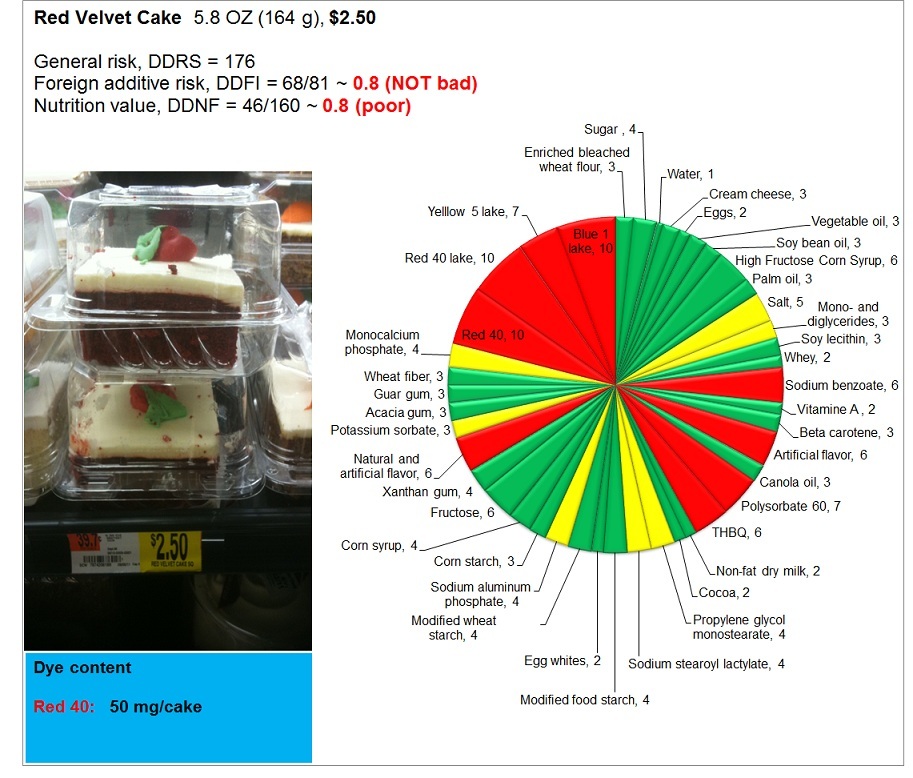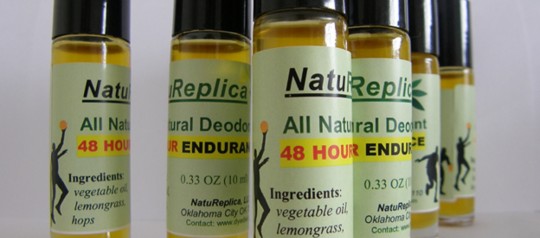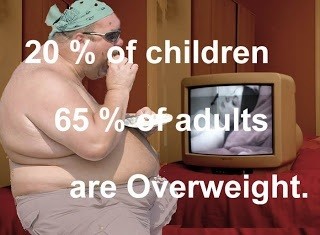Red Velvet Fake
The DyeDiet goal is not to scare you, people. The goal is to inform you about the truth behind commercial statements designed to trick you into buying the products of poor nutritional value. Sometimes truth may look scary but we have to face it in order to make right decisions. Please keep in mind that food = nutrients, not food additives and that poor nutritional value = poor health. And poor health = obesity, diabetes, depression, cancer, ADHD, Alzheimer’s, you name it but whatever comes it will make your life miserable minus all your savings spent on medical bills, so it is clear:
POOR Nutritional Value = Poor YOU
Let’s, for instance, consider another product of the Bakery at Walmart for $2.50/164 g.
DyeDiet Doesn’t Buy It!
Statement: Red Velvet Cake with real cream cheese icing, 164 g
There are only 9 main ingredients listed:
- Sugar
- Water
- Bleached enriched flour (watch video)
- Cream cheese
- Eggs
- Soybean oil
- Mono- and diglycerides, synthetic emulsifiers to fake cream in combination with an oil
- Polysorbate 60, another synthetic emulsifier to fake cream
- High Fructose Corn Syrup, a cheaper sugar substitute feared to promote cancers.
Each of the rest 33 ingredients is stated to present in 2% or lesser amount.
True value: Red Velvet Fake
It looks like a highly sophisticated composition of 42 ingredients and additives 9 of which have no use and no place in human body. I call them “foreign food additives”, not imported ones but so called xenobiotic chemicals, foreign for humans (red segments). Thus you get foreign food additive risk of DDFI = 68/81 ~ 0.8. This is actually NOT too bad but only because those chemicals are enriched with 26 nutritional ingredients and additives (green segments). While the nutrients make the cake taste edible the nutritional value is still rather poor of DDNF = 46/160 ~ 0.8 (again 0.8, simply by coincidence) further diluted by 7 benign food additives (yellow segments).
According to the Nutrition Facts sugar and HFCS form 60 g (out of the total 164 g) with less sugar, I bet. Oils, mono- and diglycerides and cream cheese (how much?) account for 26 g. Other nutrients are 20 g of carbohydrates, 6 g of protein and 2 g of fiber. The amount left after all the nutrients were subtracted is: 164 g – 60 – 26 – 20 – 6 – 2 = 50 g and therefore must be assigned to the content of all the non-nutritious additives: red and yellow segments in the diagram. It is a stunning 30% of the whole cake! Thus what you really eat with a red velvet cake of Walmart is:
- 37% by weight of HFCS and a little of sugar
- 33% of other nutrients: fats, starch, fiber and protein and …
- 30% of non-nutritious garbage!
According to the Wikipedia, “The reddish-brown color of the cake originally was from a reaction of the cocoa powder with an acidic ingredient such as buttermilk, however red food coloring is often added especially if the cake does not contain chocolate.”
Do you see cocoa listed as a main ingredient? No, you see it under “2% or less.” While it is hard to detect how much less cocoa they put, we have detected 50 mg of the artificial food colorant Red 40 instead. Well, this sounds more like “red velvet fake” to me. It is known that even lesser amounts of ~ 20 mg of food colorants may provoke ADHD syndrome in sensitive children.
To find out more about how food dyes and other additives may affect your and your child’s health read PDF files (Adobe reader needed) Food Dyes: A Rainbow of Risks and Behavior, Learning and Health: The Dietary Connection created by CSPI and Feingold Association.
What to Recommend?
Unfortunately there is NOT a single cake at Walmart that I could honestly recommend for human consumption. They ALL are of about the same poor nutritional value and high in unwelcome food additives. Sorry, people, this is the truth about fake cakes that I can see and want you to see it too.
Even if you search for a red velvet cake recipe you will find something like this one at the Food Network: Only 16 ingredients (which is great!) but… including 2 ounces (~ 30 g) of red food coloring! Indeed, the “dye diet” is in our minds and bloods…
So, please, better look for your local small bakery and find out what they offer. Hope this report will help you to make less risky food choices!
Category: Baked goods, Cakes, Food Dyes Exposure








Why do cakes at Whole Foods cost like 3 times as much as Walmart?
That’s a good question. To get an idea please compare the ingredient lists of the two.
I bet you will find that the number of ingredients is 3 or 5 times lower in the cake of Whole Foods. My guess is that they are so expensive because the overall volume of production is much lower. Small honest manufacturers are forced to charge higher prices to stay competitive with the Walmart’s garbage.